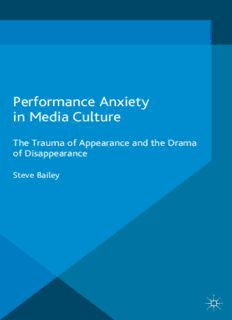Table Of ContentPerformance Anxiety
in Media Culture
The Trauma of Appearance and the Drama
of Disappearance
Steve Bailey
Performance Anxiety in Media Culture
This page intentionally left blank
Performance Anxiety
in Media Culture
The Trauma of Appearance and the Drama
of Disappearance
Steve Bailey
YorkUniversity,Canada
©SteveBailey2016
Softcover reprint of the hardcover 1st edition 2016 978-1-137-55788-9
Allrightsreserved.Noreproduction,copyortransmissionofthis
publicationmaybemadewithoutwrittenpermission.
Noportionofthispublicationmaybereproduced,copiedortransmitted
savewithwrittenpermissionorinaccordancewiththeprovisionsofthe
Copyright,DesignsandPatentsAct1988,orunderthetermsofanylicence
permittinglimitedcopyingissuedbytheCopyrightLicensingAgency,
SaffronHouse,6–10KirbyStreet,LondonEC1N8TS.
Anypersonwhodoesanyunauthorizedactinrelationtothispublication
maybeliabletocriminalprosecutionandcivilclaimsfordamages.
Theauthorhasassertedhisrighttobeidentifiedastheauthorofthiswork
inaccordancewiththeCopyright,DesignsandPatentsAct1988.
Firstpublished2016by
PALGRAVEMACMILLAN
PalgraveMacmillanintheUKisanimprintofMacmillanPublishersLimited,
registeredinEngland,companynumber785998,ofHoundmills,Basingstoke,
HampshireRG216XS.
PalgraveMacmillanintheUSisadivisionofStMartin’sPressLLC,
175FifthAvenue,NewYork,NY10010.
PalgraveMacmillanistheglobalacademicimprintoftheabovecompanies
andhascompaniesandrepresentativesthroughouttheworld.
Palgrave®andMacmillan®areregisteredtrademarksintheUnitedStates,
theUnitedKingdom,Europeandothercountries.
ISBN 978-1-349-56853-6 ISBN 978-1-137-55789-6 (eBook)
DOI10.1057/9781137557896
Thisbookisprintedonpapersuitableforrecyclingandmadefromfully
managedandsustainedforestsources.Logging,pulpingandmanufacturing
processesareexpectedtoconformtotheenvironmentalregulationsofthe
countryoforigin.
AcataloguerecordforthisbookisavailablefromtheBritishLibrary.
LibraryofCongressCataloging-in-PublicationData
Bailey,Steve,1967–
Performanceanxietyinmediaculture:thetraumaofappearanceandthe
dramaofdisappearance/SteveBailey.
pages cm
Includesindex.
1. Performingarts—Psychologicalaspects. 2. Performanceanxiety.
I. Title.
PN1590.P76B362016
791.01(cid:2)9—dc23 2015027218
Contents
Acknowledgments vi
Introduction:FacesontheStageandFacesintheStalls 1
1 TheSubjectisPerformance:GoffmanasDramaturgical
Prophet 5
2 PerformanceAnxiety:Role-ingwithLacan 26
3 LiquidStagesandMeltingFrames:Objective
De-Stabilization 44
4 FromLookingtoBeingtoKilling:PerformanceAnxietyin
RecentFrenchLanguageCinema 64
5 ProtestingDisappearance:TheDramaoftheStylishSelfin
theWorldofOOTD 99
6 ‘IForgottoRemembertoForget’or,‘RockabillyRebel,
WhatYaGonnaDo’? 138
Conclusion:PerformanceasaPsycho-ExistentialProblemor,
BetweenPerformanceStudiesandPerformativity 178
Notes 191
WorksCited 209
Index 218
v
Acknowledgments
IwouldliketothanktheFacultyofLiberalArtsandProfessionalStudies,
York University for a research fellowship that supported the comple-
tion of this book. Chris Satoor and Stephanie D’Lima assisted with the
research for Chapters 5 and 6. Thanks are also due to a number of col-
leaguesatYorkandotherinstitutionswhoprovidedfeedback,editorial
suggestions and intellectual support: Alan Blum, Kevin Dowler, David
Skinner,SusanIngram,andMarkusReisenleitner(YorkUniversity);Elke
Grenzer(YorkUniversityandtheCultureofCitiesCentre);PaulMoore
(RyersonUniversity);SaeedHydaralli(RogerWilliamsUniversity);Diego
Llovet (Cancer Care Ontario); Dan C. Shoemaker (Bowling Green State
University).
Audiences at conferences organized by the Canadian Communica-
tionAssociation,FarWestPopularCultureAssociation,CultureofCities
Centre, Society for the Study of Symbolic Interaction, and Studies in
CulturalMeaningResearchGroupprovidedfeedbackonvarioussections
of the book, and graduate students in the Joint Graduate Program in
Communication and Culture, Graduate Program in Humanities, and
Graduate Program in Science and Technology Studies have been an
enduringsourceofstimulationandinspiration.
My family have been lifelong supporters, and Herman (RIP), Gordie
(RIP),andPermiehaveconstitutedtheCanadianfelinefamily.Christina
and Alexandra have added to my life in ways impossible to measure.
Dr. Greg Dimitriadis (1969–2014) was one of my dearest friends for
nearlytwentyyearsandwillbemissed—agoodsoulandagreatfriend.
Idedicatethisbooktohim.
vi
Introduction: Faces on the
Stage and Faces in the Stalls
It came over him in especial—though the monition had, as it
happened, already sounded, fitfully gleamed, in other forms—
that the business he had come out on hadn’t yet been so
broughthometohimasbythesightofthepeopleabouthim.
She gave him the impression, his friend at first, more straight
than he got it for himself—gave it by simply saying with off-
hand illumination, ‘Oh yes, they’re types!’—but after he had
takenithemadetothefullhisownuseofit.Itwasanevening,
it was a world of types, and this was a connexion above all in
which the figures and faces in the stalls were interchangeable
withthoseonthestage.
HenryJames,TheAmbassadors(1903)
AnObject
Thisthingthathathacodeandnotacore,
HathSetacquaintancewheremightbeaffections,
Andnothingnow
Disturbethhisreflections.
EzraPound,‘AnObject’(1912)
Maple Wood, Minnesota—All the world’s a stage at some
Minnesotabars.Anewstatebanonsmokinginrestaurantsand
other nightspots contains an exception for performers in the-
atricalproductions.Sosomebarsaregettingaroundthebanby
printing up playbills, encouraging customers to come in cos-
tume, and pronouncing them ‘actors’...Owner Brian Bauman
explained. Shaping the words in his hands like producer envi-
sioning the marquee he said: ‘We call the production, “Before
1
2 PerformanceAnxietyinMediaCulture
theBan!”’Thesmokingban,passedbytheLegislaturelastyear,
allowsactorstolightupincharacterintheatricalperformances
as long as patrons are notified in advance. About 30 bars in
Minnesota have been exploiting the loophole by staging the
faux productions and pronouncing cigarettes props, according
toananti-smokinggroup.
‘MinnesotaBarsSkirtSmokingBanbyDeclaringPatronsas
Actors,’FoxNews.Com,March6,2008
Separatedbyaboutonehundredyears,James’reflectionsontheblurring
of theater and audience in the recognition of the social type, and the
literalizationofthe‘dramaofeverydaylife’inacleverlegalmaneuverof
Minnesotabarsstrugglingtopreservesmokers’rights1traceamovement
fromnovelisticinsighttoquotidianpractice.ContemporarywithJames’
novel,Pound’sreflectionsontheimpermeablecore-lessobjectintervene
toindicatesomeofthesinisterundertonestotheflatteningofmaninto
type long before such fears were a routine part of intellectual culture
andsocialthought.Collectively,theseliteraryandjournalisticmoments
offeranentrypointintothecentralfocusoftheworkthatfollows:the
cultureofperformanceanxiety.
As James’ insights demonstrate, the notion of a life/theater merger
does not begin with Erving Goffman, who inaugurates dramaturgical
sociology nearly sixty years later (with some prefiguring by Theodore
SarbinandKennethBurke,amongothers)andasPounddemonstrates,
anxiety about the ‘coding’ of the individual appears long before ‘one-
dimensionalman’(Marcuse,2013[1964])andevenabitbeforethe‘man
without qualities’ (Musil, 1963 [1930]). Certainly, concern for one’s
appearance and for the cultivation of appropriate social role-playing
techniquesisasoldassocialinteractionitself,andwaslikelyamplified
by the diversification and to a degree unmooring of selfhood associ-
ated with modernity (see Giddens, 1991, among many others). What
has emerged in more recent decades is the proliferation of a reflexive
andpersistentrevisitationofthetheatricalconstructionofsubjectsand
situations,aswellasarangeofculturalpracticesthatreflecttheanxious
spirit of this dramaturgical reflexivity; some practices transform anxi-
eties regarding performance into opportunities for radical self-creation
while others seek a therapeutic reassurance that life and theater can
coexist with a modicum of authenticity. Understanding such phenom-
ena requires a recognition of their three-dimensional character: they
reflectproblemsofsocialpractice,problemsofdesiringsubjects(Pound’s
‘acquaintance’doesnotentirelyobliterate‘affections’),andproblemsof
asocial-symbolicorder.
Introduction 3
This volume is structured around these dimensions in its first three
chapters,witheachconnectingakeythinkerwithananalyticaldimen-
sion. The first chapter, ‘The Subject is Performance: Goffman as a
Dramaturgical Prophet,’ re-examines the work of Erving Goffman as a
substantive theory of subjectivity, against critics and even supporters
offering a more restricted view of his career achievements. The sec-
ond, ‘Performance Anxiety: Role-ing with Lacan,’ explores avenues of
engagement between Goffman’s dramaturgical sociology and Lacanian
psychoanalysis; while such a dialogue would never square with ortho-
dox Lacanianism—nor with narrowly sociological interpretations of
Goffman—I find some intriguing consonances in the two traditions.
Thefinaltheoreticalchapter,‘LiquidStagesandMeltingFrames:Objec-
tiveDe-Stabilization,’addsthelaterworkofJeanBaudrillardalongwith
thatofsomekindredphilosophicalspiritstothemix,andnecessarilyso,
asBaudrillardprovidesthegroundsforananalysisofthelargerculture
upon which desire-charged social subjects enact various social dramas.
Thethreetheoreticalchaptersaredesignedbothtoprovideananalytic
apparatus for the cases that follow in Chapters 4–6, but also to act as
akindoffreestandingargumentforthisunusualcombinationofsocial
theorists.
The three case studies that followare likewise eclectic in nature,tak-
ingon,respectively,depictionsofperformanceanxietyincontemporary
cinema, the virtual world of outfit of the day blogs and vlogs, and
the subculture associated with rockabilly music and corollary styles.
The cases are designed along several axes of comparison, with a range
of aesthetic preoccupations (art cinema, clothing, and music), as well
as differing forms of expression and communication (filmic, digital,
and proximate/concrete rituals); they also reflect contrasting biases in
termsofthecentralpreoccupationsregardingaperformingsubjectivity,
with the first emphasizing a formalist analysis of the symbolic charac-
ter of contemporary culture, the second the enunciation of reflexive
discourses of self-presentation and obsessive thematization of every-
day aesthetic decisions, and the third a time-bending enactment of
cultural-historical personae between nostalgia and critique. By provid-
ingconcentratedexamplesofkeyculturaltendencies,thecasesarethus
intendedasallegoriesforamuchlargersetofculturalpracticesandori-
entationstoprocessesofsubject-formationandrole-performance.They
are also explored, in the spirit of the Baudrillardian seduction, with a
willingnesstoenterintothemontheirowntermsbutnevertosurren-
dertoomuchground;thegoalisnotsomuchdemystificationasakind
ofcontrapuntalanalysis,astrategywithitsownrisks,asBaudrillardwas
quicktorecognize.

